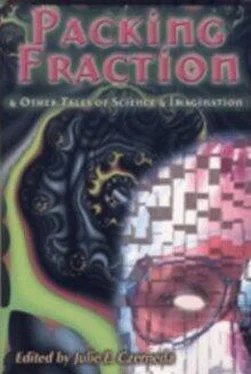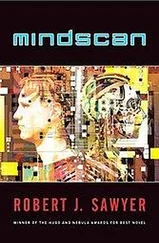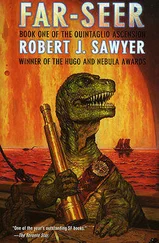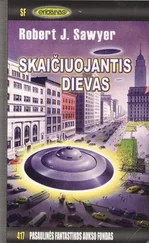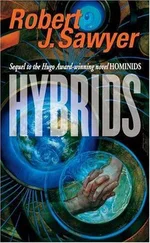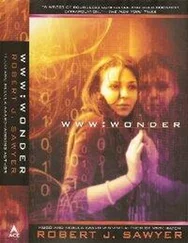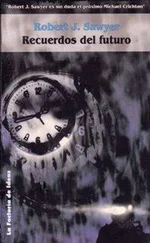Robert Sawyer - Stream of Consciousness
Здесь есть возможность читать онлайн «Robert Sawyer - Stream of Consciousness» весь текст электронной книги совершенно бесплатно (целиком полную версию без сокращений). В некоторых случаях можно слушать аудио, скачать через торрент в формате fb2 и присутствует краткое содержание. Год выпуска: 1999, ISBN: 1999, Издательство: Trifolium Books, Жанр: Фантастика и фэнтези, на английском языке. Описание произведения, (предисловие) а так же отзывы посетителей доступны на портале библиотеки ЛибКат.
- Название:Stream of Consciousness
- Автор:
- Издательство:Trifolium Books
- Жанр:
- Год:1999
- ISBN:1-895579-89-9
- Рейтинг книги:3 / 5. Голосов: 1
-
Избранное:Добавить в избранное
- Отзывы:
-
Ваша оценка:
- 60
- 1
- 2
- 3
- 4
- 5
Stream of Consciousness: краткое содержание, описание и аннотация
Предлагаем к чтению аннотацию, описание, краткое содержание или предисловие (зависит от того, что написал сам автор книги «Stream of Consciousness»). Если вы не нашли необходимую информацию о книге — напишите в комментариях, мы постараемся отыскать её.
Stream of Consciousness — читать онлайн бесплатно полную книгу (весь текст) целиком
Ниже представлен текст книги, разбитый по страницам. Система сохранения места последней прочитанной страницы, позволяет с удобством читать онлайн бесплатно книгу «Stream of Consciousness», без необходимости каждый раз заново искать на чём Вы остановились. Поставьте закладку, и сможете в любой момент перейти на страницу, на которой закончили чтение.
Интервал:
Закладка:
“What?”
“That one there,” she said, pointing to a chemical formula being displayed on her scanner’s screen. “It looks like—incredible.”
“What?” asked Tina, sounding rather frustrated at being the only one with no medical or biological training.
“It’s a neurotransmitter,” said Raji. “At least, I think it is, judging by its structure. Neurotransmitters are the chemicals that transmit nerve impulses.”
“There’s lots of it in the blood,” said Cardinal, pointing at a figure.
“Can you show me some blood while it’s still in the body?” asked Raji.
Cardinal nodded. She pulled a very fine fibre optic out of the side of her scanner, and inserted it into the same distended blood vessel Bancroft had extracted the sample from earlier.
On the scanner’s screen, blood cells could be seen moving along in unison.
“They’re all going the same way,” said Raji. “Even without a heart to pump them along, they’re all traveling in the same direction.”
“Maybe that’s why there are neurotransmitters in the bloodstream,” said Bancroft. “The blood cells communicate using them, so that they can move in unison.”
“What about the head injury?” asked Tina. “If it’s got all that blood, why isn’t it bleeding?”
Cardinal moved the scanner up to the alien’s small, spherical head. The eyes were still closed. On the LCD screen, the skull was visible beneath the skin, and, beneath the skull, the scanner outlined the organ that was presumably the brain within.
“It’s so tiny,” said Raji.
Bancroft indicated the spaceship around them. “Well, despite that, it’s obviously very advanced intellectually.”
“Let’s have a look at the wound,” said Raji.
Cardinal repositioned the scanner.
“There seem to be valves in the broken blood vessels that have closed off,” she said.
Raji turned to Tina. “We’ve got valves in our veins, to keep blood from flowing backwards. It looks like this creature has valves in both its veins and its arteries.” He paused, then turned to Cardinal. “I still don’t know if we can or should move the alien.”
“Well, the oxygen bottle is almost empty,” said Bancroft. “Who knows if it was doing it any good, anyway, but—”
“Oh, God,” said Tina. She’d still been holding her hand near one of the respiratory orifices. “It’s stopped breathing!”
“We could try artificial respiration,” said Bancroft.
“You mean blowing into its hands?” said Tina incredulously.
“Sure,” said Bancroft. “It might work.” He lifted one of the arms, but, as he did so, orange liquid began to spill from the breathing hole.
“Yuck!” said Tina.
Raji pulled back, too. The head wound had started to bleed as well.
“It’s bleeding from the mouths, too,” said Cardinal, looking at the medial limbs.
“We can’t let it die,” said Raji. “Do something!”
Bancroft reached into the medical kit and brought out a roll of gauze. He began packing it into the mouth located in the palm of the right medial hand. Cardinal grabbed a larger roll of gauze and tried to stanch the flow from the head.
But it was no good. Orange liquid was seeping out of previously unnoticed orifices in the torso, too, as well as from the soles of the feet.
“It’s dying!” said Tina.
Blood was pooling on the spaceship’s floor, which was canted at a bit of an angle.
“Maybe one of our viruses has the same effect on it that Ebola has on us,” said Bancroft.
But Raji shook his head. “Viruses evolve in tandem with their hosts. I find it hard to believe any of our viruses or germs would have any effect on something from another ecosystem.”
“Well, then, what’s happening to it?” asked Bancroft. And then his eyes went wide. Raji followed Bancroft’s gaze.
The orange blood wasn’t pooling in the lowest part of the floor. Rather, it was remaining in a puddle in the middle of the floor—and the puddle’s edges were rippling visibly. The middle of the pool started to dry up. As the four humans watched, the opening in the middle grew bigger and bigger. But it wasn’t round—rather, it had straight edges. Meanwhile, the outside of the puddle was also taking on definite shape, forming straight edges parallel to those on the inside.
“It’s—it’s a triangle ,” said Tina.
“The orange pigment in the blood—it’s probably iron-based,” said Raji. “Maybe it’s magnetic; maybe the blood is pooling along the field lines formed by magnetic equipment beneath the hull…”
But then pairs of liquid arms started extending from the vertices of the central triangle. The four humans watched dumbfounded while the blood continued to move. Suddenly, the six growing arms turned in directions perpendicular to the way they’d previously been expanding.
Finally, the outline was complete: the central object was a right-angle triangle, and off of each face of the triangle was a square.
Suddenly, lines started to cross diagonally through two of the squares—one square was crossed from the lower-left to the upper-right; another from the upper-left to the lower right; and the third—
—the third square was crosshatched , as if the patterns from the other squares had been overlain on top of each other.
“The square of the hypotenuse,” said Tina, her voice full of wonder, “equals the sum of the squares of the other two sides.”
“What?” said Bancroft.
“The Pythagorean theorem,” said Raji, absolutely astonished. “It’s a diagram illustrating one of the basic principles of geometry.”
“A diagram made by blood ?” said Bancroft incredulously.
A sudden thought hit Raji. “Can your scanner sequence nucleic acids?” he asked, looking at Cardinal.
“Not quickly.”
“Can it compare strands? See if they’re the same?”
“Yes, it can do that.”
“Compare the nucleic acid from a body cell with that from one of the blood cells.”
Cardinal set to work. “They don’t match,” she said after a few minutes.
“Incredible,” said Raji shaking his head.
“What?” said Tina.
“In all Earth lifeforms, the DNA is the same in every cell of the body, including in those blood cells that do contain DNA—non-mammalian red corpuscles, as well as white corpuscles in all types of animals. But the alien’s blood doesn’t contain the same genetic information as the alien’s body.”
“So?”
“Don’t you see? The blood and the body aren’t even related! They’re separate lifeforms. Of course the body has a tiny brain—it’s just a vehicle for the blood. The blood is the intelligent lifeform, and the body is only a host.” Raji pointed at the orange diagram on the floor. “That’s what it’s telling us, right there, on the floor! It’s telling us not to worry about saving the body—we should be trying to save the blood!”
“That must be why the host has built—in valves to shut off cuts,” said Cardinal. “If the blood cells collectively form an intelligent creature, obviously that creature wouldn’t want to give up part of itself just to clot wounds.”
“And when the host dies, the orifices and valves open up, to let the blood escape,” said Bancroft. “The host doesn’t hate the blood—this isn’t an enslavement; it’s a partnership.”
“What do we do now?” asked Tina.
“Collect all the blood and take it somewhere safe,” said Raji. “Then see how much we can communicate with it.”
Интервал:
Закладка:
Похожие книги на «Stream of Consciousness»
Представляем Вашему вниманию похожие книги на «Stream of Consciousness» списком для выбора. Мы отобрали схожую по названию и смыслу литературу в надежде предоставить читателям больше вариантов отыскать новые, интересные, ещё непрочитанные произведения.
Обсуждение, отзывы о книге «Stream of Consciousness» и просто собственные мнения читателей. Оставьте ваши комментарии, напишите, что Вы думаете о произведении, его смысле или главных героях. Укажите что конкретно понравилось, а что нет, и почему Вы так считаете.
